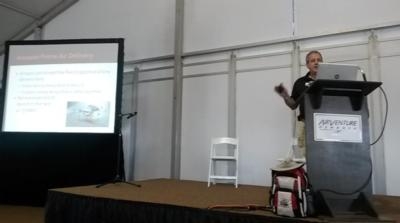Small Unmanned Aerial Systems Can Go Where People Can Not
By Maria Morrison
In the summer of 1961, the first robot was introduced into the General Motors assembly line. Today, we are looking at a future of robots everywhere. Robots delivering our packages, robots investigating crime scenes, robots surveying terrain. These all fit into a specific category of robots called Small Unmanned Aerial Systems (sUAS), commonly referred to as drones.

Those promoting the use of sUAS avoid using the term "drone" due to its predatory connotation. Norm Isler of SkyOp gave a presentation on Thursday about the many benefits of sUAS, and how they should not be associated with whatever negative images are brought to mind by the word "drone".
The purpose of sUAS falls into two main categories: delivery and data gathering. Amazon has been experimenting with the delivery aspect of sUAS for a while, but is yet to find a solution. Currently, only thing that they could send are paperclips, and the shipping costs are exorbitant. Not to mention the danger of sending a robot out of the line of sight of the operator and unto someone's front porch.
Another delivery idea is being experimented with by first responders. A sUAS can travel in a straight line to the location of a 911 call at up to 100 mph. This sUAS could deliver a defibrillator and two-way radio. This way, a medic could tell someone nearby how to use the defibrillator and revive someone before first response gets to the scene. If this were successful, heart-attack victim survival rates could rise up to 80%, Isler says.
Data gathering seems to be the route with less room for human error. A sUAS can be programmed to fly a specific route every day and take photos or readings at the same point each day. This could be used to monitor crop growth, progress on a building project, or inspect bridges. Isler and his fellow SkyOp sUAS operators are coming up with dozens of new ideas every day. Manual override of the sUAS is available at any time.
Isler believes that there are many jobs currently done by humans that would be completed faster and safer by robots. They can go into hazardous situations that law enforcement would have to go into. For example, sUAS can fly into a hostage or hazmat situations without risking lives. Robots can replace humans at dirty, dangerous factory jobs.
Currently, sUAS can only be operated under model airplane rules, so they must be under 55 pounds, stay below 400 feet, and remain in the line of sight of the operator. The FAA is proposing a new set of rules for sUAS that they must be under 55 pounds, stay below 500 feet, under 100 mph, remain in the line of sight, stay out of airspace, and be operated in the daylight. The operator needs to take a written every two years, be over 17, and TSA approved.
Isler insists that drones will create more jobs for people too. He realizes that sUAS and other robots will be taking jobs from people, but every piece of equipment needs someone to monitor it, clean it, and fix it when it breaks. "That creates three more jobs and only takes away one."
 ANN's Daily Aero-Linx (05.02.24)
ANN's Daily Aero-Linx (05.02.24) ANN's Daily Aero-Term (05.02.24): Touchdown Zone Lighting
ANN's Daily Aero-Term (05.02.24): Touchdown Zone Lighting Aero-News: Quote of the Day (05.02.24)
Aero-News: Quote of the Day (05.02.24) ANN FAQ: Contributing To Aero-TV
ANN FAQ: Contributing To Aero-TV NTSB Final Report: Cirrus Design Corp SR20
NTSB Final Report: Cirrus Design Corp SR20



